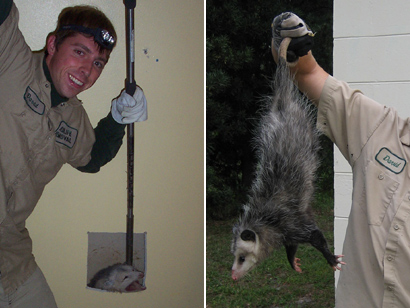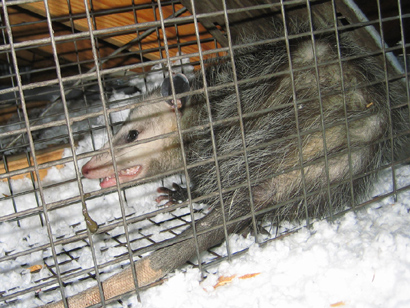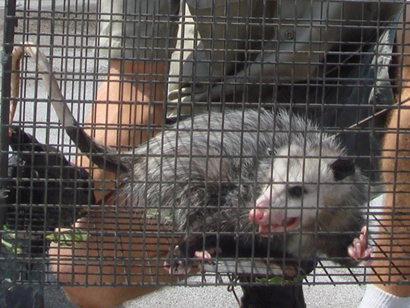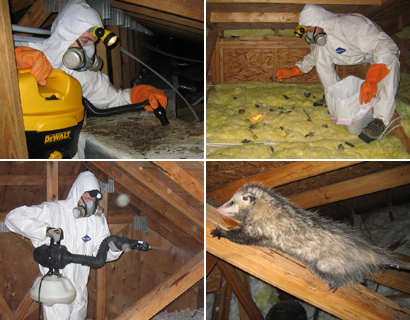- Opossum Removal - Information about the humane trapping and removal of opossums.
Opossum Removal
COMMON PROBLEMS: Opossums are nocturnal, largely nomadic, and common on urban areas. They are highly adaptable, and can live almost anywhere and eat almost anything. Thus they often use human shelter and food sources. They are gentle animals, for the most part, but can defend themselves if necessary - if they don't "play possum", that is. Female opossums can have two litters per year, and often seek out attics or under buildings to have a safe place while the young, clinging to mama possums's back, grow. They cause some of the following problems:
- Breaking into an attic, and setting up a nest
- Crawling under a shed, porch, or deck and living there
- Eating from garbage cans, pet food, bird seed, etc.
- Depositing feces in swimming pool, on porch, yard, etc.
- Concern about a sick or rabid opossum on property.
- Dead opossum under building, in attic, in yard, etc.
OPOSSUM IN THE ATTIC: Yes, this does happen quite frequently (see photo to left and below), and this is a very complex case. This almost always involves an adult female with baby possums. The baby opossums usually cling to their mother, but they drop off one by one as they grow, and it's very common for small ones to rome around in the attic, and fall down walls or other cavities. There they will call out with a kind of chirping call, and if not removed, will die and cause an odor problem. Here are the general steps for removing opossums from an attic.
- Step 1: Inspect the home, and find the entry hole(s), which are very large and obvious.
- Step 2: Enter the attic. If you find the adult female, catch her via snare pole.
- Step 3: Search the attic carefully, and find and remove any baby possums by hand.
- Step 4: If you couldn't find and remove them all (very hard to do), you will have to set traps. This is pretty much the only species for which traps in the attic will be successful.
- Step 5: Once they are all out, repair the entry holes with pro-grade repairs.
- Step 6: Clean the attic, removing all feces, and spray with enzyme cleaner.
GENERAL OPOSSUM TRAPPING: Opossum trapping is subject to state laws regarding capture and relocation or euthanization of wildlife. If you have unwanted possums outside the home, in some cases, the only fix is to trap and remove the nuisance wildlife. We can safely, legally, and effectively catch and remove your nuisance opossums. Trapping is an art, and most amateur attempts go awry for a variety of reasons. An intimate knowledge of opossum behavior, both prior to and after trapping, and of various opossum trap types is necessary to ensure that the possum is trapped and removed without incident.
- STEP 1: Determine if trapping is necessary, or if there is a preventative alternative.
- STEP 2: Select the right trap for the situation, of at least a dozen types of opossum traps.
- STEP 3: Set the traps in the correct areas, in the shade, camouflaged, on a flat sturdy surface, away from any obstructions or areas that can be damaged, etc.
- STEP 4: Use the correct bait. Don't use meat-based baits, which can attract stray cats.
- STEP 5: Monitor the trap daily, remove trapped opossums (carefully!) & transport them.
ATTIC DECONTAMINATION & OTHER SERVICES: In some situations, it may be desirable to clean your attic after you've removed opossums from the space. They can leave behind large amounts of droppings, urine, hair, oils, food, nesting material, and so on. These remnants can attract insects like cockroaches, and the scent left behind can encourage new possums to attempt to chew or break their way into your house. You might also experience odor problems from the waste. It's possible or likely that mold will grow on the areas of feces and urine, and urine can damage wood or sheetrock. Some of the mold can potentially cause diseases that people can catch, and some of the feces themselves can cause diseases, such as Salmonella or Leptospirosis. It's also adviseable to repair any torn ductwork in an attic, along with any torn pipe insulation or chewed electrical wires.
- We remove or vacuum all droppings, or remove all the soiled insulation.
- We fog the attic with a special enzyme-based cleaner that destroys any organic matter and deodorizes the space.
- We repair damage, such as ductwork, electrical wires, pipes, insulation, and more.
Learn more About opossums biology including why do Opossums play dead, and how big opossums get. Learn, too, all about the opossum tail. We have information about whether or not it is safe to handle an opossum with bare hands. Learn about the dangers surrounding opossum feces as well as urine, as well as some of the symptoms of a sick opossum and what diseases opossums may carry. We can also answer the question: Is an opossum that is active during the daytime sick or rabid?. Learn about opossum mating habits and their typical habitats, and What is a opossum’s natural diet, and how does it get its food?.
My years of expertise can help you figure out general Opossum Prevention, as well as How To Get Rid of Opossum if one has already found its way to your property. We can also answer questions about How To Trap a Opossum, and if it is legal for me to trap an opossum. Read about What equipment is needed to trap an opossum?, What Bait Catches Opossum, where should you relocate a trapped possum, and an analysis of different Opossum Repellents, and if a high pitch sound deterrent machine work against opossums. We also get a lot of questions about whether or not mothballs or ammonia help repel opossums and offer our advice. Learn, too, What should I do with an opossum after I catch it?. I've seen it all, so I can even offer specific advice about what to do if you find Opossum in the Attic and How to get opossums out of your attic, what do do about Opossum on the Roof and Opossum Under a Shed or Deck, even Opossum in Your House. If you think you might have an opossum under your shed or porch, will help you decide if an opossum is what you're dealing with, and if an opossum under a shed or porch have a nest of babies. We also have information about How to get opossums out from inside a wall, and what to do if you find a Dead Opossum. If the critter hasn't yet made it's way into your domicile, we have advice about How to keep Opossums out of my garden , or garbage cans.
One question we often get is How to Kill a Opossum, as well as humane ways to kill an opossum, and whether this is the best approach. Learn about Opossum Poison and what might be legal in your state, and if it is even a good option.
Here is some info about Baby Opossum, and what to do if you find an orphaned baby opossum or a nest of baby opossums, as well as whether or not you should feed a baby opossum.
No doubt these creatures are a nuisance - learn more here about what diseases do opossums carry. It's important to protect yourself and your family by learning how to keep opossums away from your property, as well as learning What attracts opossums so you can better safeguard your home. Take steps now to prevent significant damage later. We can answer questions as to whether or not a pest control company remove Opossum, as well as if you should hire a pro or attempt to remove Opossums yourself. We have information about Will the city or county animal services help me with an Opossum issue?. We've even been asked if opossums make good pets.
Learn more about oppossums through these links:
Dead opossums - How to find and remove a dead oppossum in or on your property
Opossum bait - What is the best bait to use to trap an opossum
Opossum in attic - How to get rid of opossums in your attic
Opossum Inside - What to do if an opossum got in your house
Wildlife Rehabilitators - What do wildlife rehabilitators do with opossums?
Opossum Yard - What are some ways to kill a opossum in the yard?
Opossum Feces - How to clean up opossum feces you find in your home
Virginia Opossum Biology and Information
The scientific term for this mammal is didelphis virginiana and they’re the only marsupial that is indigenous to North America. They are scavengers that have pointed snouts and long naked tails. They are very diverse and adaptable animals able to set up nests and dens in many different environments.
Biology - These animals generally weigh about twelve pounds, some a little lighter and others a couple of pounds heavier. Many people describe them as looking like large rats and this is quite accurate. They have a prehensile tail and more teeth than any mammal and are very short lived, generally less than three years. Some people don’t realize they have very dexterous front paws and that they have opposable thumbs. When confronted they will often stand their ground and if they feel threatened they have even been known to keel over as though they passed out or died. This is where the phrase ‘playing possum’ comes from. They are omnivores and as such they have an extremely large range of items on their menu. They will dine on dead animals, bugs, pet food, garbage, bird nests and anything in between. They are also nocturnal creatures so do their foraging at night. One little known fact about these mammals is that they are known to have outstanding immunity systems. They have full immunity to many different types of venom from deadly snakes especially those in the pit viper family.
Life Cycle And Reproduction - These animals are marsupials and this means they give birth to tiny babies that crawl along their fur to live in their pouch for some time. They have had as large of litters as thirteen but more often have numbers in the four to seven ranges; at least that survive to the stage outside the pouch. Inside the pouch they attach to a teat where they feed for the next seventy days before they are start to get weaned. After which they ride around with mom and learn to forage before going off on their own.
Habitat - The Virginia Opossum is a highly adaptable creature, able to make homes in many different environments. When their range is outside of an urban population they will create their homes in tree hollows, rotted logs and other burrows. They will scavenge off of dead animals, road kill and river banks. They can climb up trees and are quite agile when moving about. If living closer to a population of people they will have a tendency to look for easy access to shelter in buildings. Sheds, attics and barns are particular favorites for them to return to and create a nest.
Common Diseases Possums Can Spread - These mammals don’t often carry rabies as many people assume, in fact being far less likely than a wild dog. They are harbingers of many other problems, though. These may come in the form of worms and other parasites that will get passed through their feces. They will also carry mites, fleas and ticks in their fur which these parasites come with a host of health problems. Both Salmonella and Leptospirosis can be carried and spread through their droppings as well.
Common Nuisance Complaints - It is not unusual for people to complain about these animals finding their way under a home and making a nest. They will steal cat food and tip over rubbish bins to feed off of the trash from people’s homes. It’s not uncommon for one to make a nest in the garage or attic and cause quite a bit of destruction this way. Where ever they set up a nest area they will also set up a bathroom area. This can cause a host of problems in the form of harmful bacteria carried in their droppings. The chemicals can also rot flooring or ceilings depending on where they have decided to nest.
Opossum diseases – an analysis
Rabies? - Although the rather strange looking marsupial, the opossum, is not a creature that you normally associate with rabies, as you would with many other wild animals, especially if you have pets of your own to deal with, it can still carry a large amount of diseases, most of which can prove to be rather deadly for humans – adult and children alike. It is wise to know about the dangers and concerns, especially if you have fallen prey to an opossum invasion before, and this is very much so the case if you have other animals living in your home, or children to watch out for at the same time.
Common possum diseases - Among the most popular disease that you will find with the opossum are toxoplasmosis, spotted fever, trichomoniasis, relapsing fever and leptospirosis. Rabies is not a concern, as we have mentioned, simply because the body temperature of the animal is rather low, creating an environment that the virus cannot usually survive in. You will also have to be careful of mites, fleas and ticks, especially if you have cats, dogs and other household animals.
Toxoplasmosis - for example, is a very dangerous disease to humans, both adults and children alike, and although is a disease usually carried by cats, (which is why you should ensure that the opossum and cat never come into contact with each other) can be passed over by an opossum. Contaminated food and soil are the usual culprits here, so if you have an opossum in your home, or food growing in your yard, you should avoid eating them if you have noticed a presence of this animal.
Leptospirosis - is again, a rather unfriendly bacterial infection that humans can get, usually from contaminated water. If you think that your new opossum addition could have peed anywhere near the water you would use to drink, wash, or clean with, you need to do something about it urgently. Nasty symptoms, including nausea, muscle pains and spasms, headaches and fevers are associated with this disease, and they normally come along around ten days after first infection. The moral of the story is if you have an opossum invasion – get wildlife professional to fix it. Although the chances of your opossum having these diseases is rare, there is a still a chance that it could happen!





